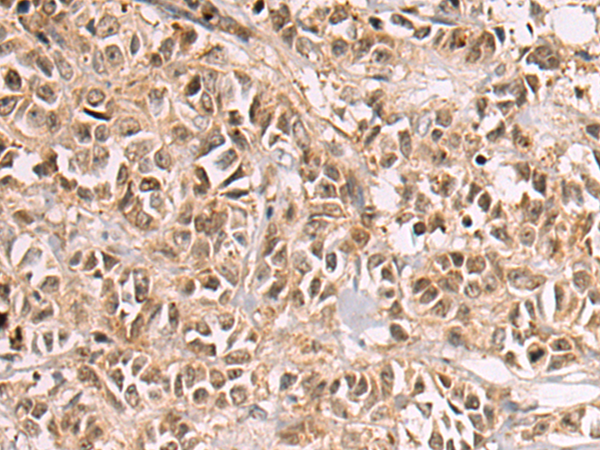
| WB | 咨询技术 | Human,Mouse,Rat |
| IF | 咨询技术 | Human,Mouse,Rat |
| IHC | 1/50-1/100 | Human,Mouse,Rat |
| ICC | 技术咨询 | Human,Mouse,Rat |
| FCM | 咨询技术 | Human,Mouse,Rat |
| Elisa | 1/5000-1/10000 | Human,Mouse,Rat |
| Aliases | RBM35A; RMB35A; DFNB109 |
| Host/Isotype | Rabbit IgG |
| Antibody Type | Primary antibody |
| Storage | Store at 4°C short term. Aliquot and store at -20°C long term. Avoid freeze/thaw cycles. |
| Species Reactivity | Human, Mouse, Rat |
| Immunogen | Synthetic peptide of human ESRP1 |
| Formulation | Purified antibody in PBS with 0.05% sodium azide and 50% glycerol. |
+ +
以下是3篇关于ESRP1抗体的参考文献及其摘要要点:
---
1. **文献名称**: *ESRP1 regulates alternative splicing of key cancer genes in triple-negative breast cancer*
**作者**: Warzecha, C.C. et al.
**摘要**: 研究利用ESRP1抗体检测其在三阴性乳腺癌细胞中的表达,发现ESRP1通过调控CD44、FGFR2等基因的选择性剪接,影响肿瘤细胞的侵袭和转移能力。
---
2. **文献名称**: *Epithelial splicing regulatory protein 1 (ESRP1) promotes glioblastoma tumor cell heterogeneity*
**作者**: Dhamija, S. et al.
**摘要**: 通过ESRP1抗体染色发现,ESRP1在胶质母细胞瘤中高表达,并通过调控细胞黏附相关基因的剪接,促进肿瘤异质性和化疗耐药性。
---
3. **文献名称**: *ESRP1-controlled splicing programs regulate cancer cell plasticity through EMT and metabolic adaptation*
**作者**: Yang, Y. et al.
**摘要**: 使用ESRP1抗体进行功能研究,揭示ESRP1通过调控上皮-间质转化(EMT)相关剪接事件及代谢基因,驱动癌细胞可塑性和转移。
---
**备注**:以上文献为代表性研究方向,实际引用时建议通过PubMed或Google Scholar核对最新进展。
The Epithelial Splicing Regulatory Protein 1 (ESRP1) is an RNA-binding protein critical for regulating alternative splicing events in epithelial cells. It governs the production of splice variants that maintain epithelial phenotypes by modulating cell adhesion, polarity, and signaling. ESRP1 is particularly notable for its role in the epithelial-mesenchymal transition (EMT), a process central to development, wound healing, and cancer metastasis. During EMT, ESRP1 expression is downregulated, promoting a shift to mesenchymal splicing patterns that enhance cell motility and invasiveness.
ESRP1 antibodies are essential tools for studying its expression, localization, and functional roles. They are widely used in techniques like Western blotting, immunofluorescence, and immunohistochemistry to assess ESRP1 levels in tissues or cell lines, particularly in cancer research. Reduced ESRP1 expression correlates with poor prognosis in carcinomas, making it a potential biomarker for metastatic potential. Additionally, these antibodies aid in exploring ESRP1's interaction with RNA targets and its regulatory crosstalk with signaling pathways (e.g., FGFR2 or CD44 splicing).
Research on ESRP1 antibodies also supports therapeutic investigations, as restoring ESRP1 activity might counteract pro-metastatic splicing programs. However, challenges remain in standardizing antibody specificity across experimental models. Overall, ESRP1 antibodies are pivotal for unraveling post-transcriptional mechanisms in epithelial biology and disease.
×